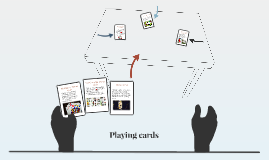Playing Cards
Transcript: When Europeans first acquired playing cards they took the art of card making seriously. These "engravers" were responsible for creating many of the artistic scenes seen on historical manuscripts. Europeans were one of the first groups to bond upper and lower class citizens through a game. Family Culture A Culture Shock: Gambling Lo, Andrew. "The Game of Leaves: An Inquiry into the Origin of Chinese Playing Cards." Bulletin of the School of Oriental and African Studies, University of London Vol. 63, no. 3, 2000, pp. 389-406. Uhlendorf, B. A. "The Invention of Printing and Its Spread till 1470: With Special Reference to Social and Economic Factors." The Library Quarterly: Information, Community, Policy vol. 2, no. 3, 1932, pp. 179-231. Golz, David. “Playing Cards on the Early English Stage.” University of Nevada, Reno, ProQuest Dissertations and Theses, 2002, pp. 96–135. Wintle, Simon. “Playing Cards & Gaming.” The World of Playing Cards, The World of Playing Cards, 17 Sept. 2016. Raiser, Maria. “The History of Playing Cards and Tarot.” Order of Bards and Druids, The Order of Bards, Ovates, and Druids. Wintle, Adam. “U. S. A.” The World of Playing Cards, The World of Playing Cards, 22 July 2016. Weiser, Kathy. “The Frontier Gambler.” Old West Legends, Legends of America, 1 Oct. 2016. In the Beginning Bibliography Tarot cards have been around since 12th century but didn't gain their "mystical powers" until two centuries later. In fact, the original Tarot Card deck was used for simple games. It was only when a "book of fates" was published that people began to view the ordinary cards with mystical properties. 14th century European card makers were the first to make common styles of cards. Their playing cards shifted the style to a point where they almost look like the modern style that we use today. It wouldn't be until the 1890s in the United States that playing cards would receive their modern age shape and design. Appearance is Everything When tarot cards first came into being they were much larger than their counterparts. It was this difference in size that reversed the roles between the two decks. It is also widely believed that the increased variation of the tarot card deck and lack of repetitiveness makes for better divine results. Gambling has a long and somewhat storied history with playing cards. Almost immediately after their arrival in Europe they had bans placed on them from church for their affiliation with gambling. Some card makers tried to go around the ban by creating cards that depicted religious icons in order to appease the church. The Movement West Educational Benefits Playing Cards: Gambling hasn't always held a bias toward card games. Despite common themes in Hollywood films, Poker didn't become a huge hit with the nation until the 1960s and 70s. Many card games experienced name changes due to the influence that gambling had on national culture. Mystical Practices: The Tarot Card Many people think of playing cards and see only gambling but this isn't necessarily true. Educational games have been around for several hundred years and are known to increase learning potential. Card games are extremely valuable as educational tools because they can be used for improving memory and teaching young children how to follow basic rules. Playing cards made their first migration west around the middle of the 11th century. It wasn't until the 17th century that playing cards would find their way to the America's. As cards continuously swept across continents and oceans they began to change the basic culture of society and how we think about others. Cards and Europeans A Change of Face The Influence on America Thought to have originated in 10th century China. Formed from a combination of the "yezi" or Game of Leaves and wine drinking games. Rules of the game had similarities to card games known today but used dice instead of paper cards. Another theory tells of an origin in India as their ancient playing cards more closely resemble European playing cards. And Their Influence on Culture The Influence Playing cards have long been a part of family traditions. In an age where kids are more interested in TV and video games, card games remain a viable solution for parents to form better bonds. Playing cards also offer a way for families to enjoy other aspects of entertainment such as magic tricks or card houses. Gambling and American Culture Playing cards are a double-bladed sword in regards to culture. Although it is such a small item its disappearance would have a dramatic effect on multiple aspects of culture across the world. It is extremely likely that, due to the unstable nature of the playing cards, in the next hundred years they will evolve into something different again and continue their influence on the world. The United States has been responsible for a large shift in the creation and distribution of playing cards. Once playing cards were introduced into the United States, Americans experienced a

















